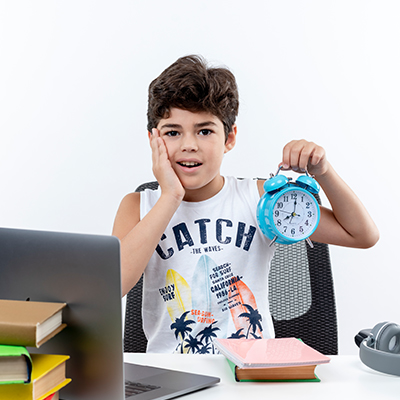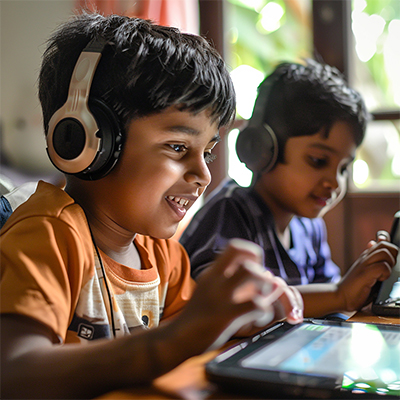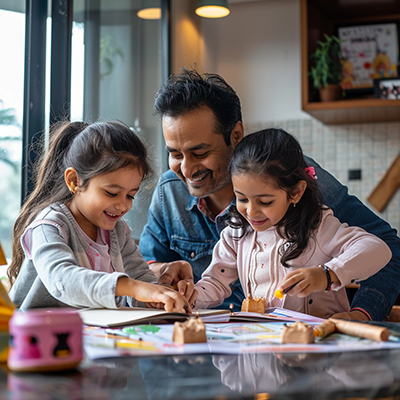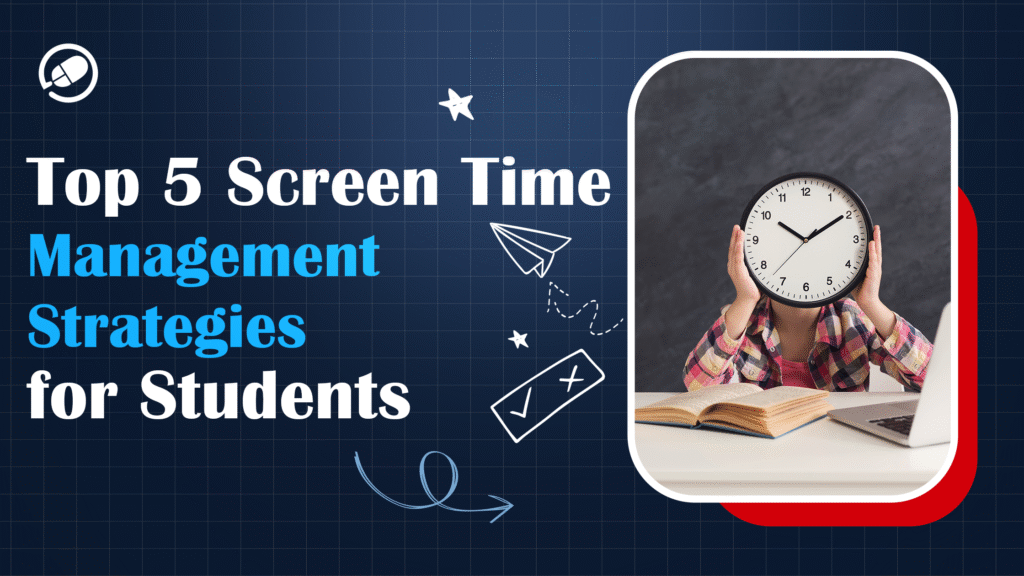If you’re a parent or a student, you know how easy it is for screen time to get out of control. Between online classes, social media, and gaming, the average student today spends 6–8 hours a day on screens outside of schoolwork. But here’s the problem: too much screen time can lead to sleep problems, poor grades, anxiety, and even phone addiction.
In this blog, we’ll cover the five best screen time management strategies for students, backed by research, practical tips, and tools that every family can use.
Why Screen Time Management Matters for Students

Balancing screen time for kids and teens today isn’t just about saying “no more video games.” It’s really about teaching your kids self-discipline and helping them make choices that support online learning, health, and happiness.
How Much Time Do Kids Spend on Screens?
- By age 2, children already spend about 2.5 hours daily on technology, and by ages 5–8, this rises to 3.5 hours per day, showing how quickly screen exposure increases with age.
- While overall daily screen time has stayed steady since 2020, gaming time has surged by 65%, reflecting a major shift in how children use screens.
- According to Consumer Affairs, at the age of 15, almost all children have a cell phone.
- Teens spend about 7 hours and 22 minutes on screens every day. That’s almost half of the time they are awake.
When screen time goes unchecked, here’s what often happens
- More stress and anxiety – More than half of teens say they feel anxious when they are staying away from their phones, a clear sign of growing digital dependency for both students and families.
- Lower grades—Constant notifications and multitasking kill focus.
- Obesity—Kids who spend more than 2 hours a day on screen have a 42% of risk of being overweight
- Sleep struggles—About 6 out of 10 teens who stay on their phones at night find it hard to fall asleep.”
- Family conflict—Too much screen time often leads to arguments over rules, which creates tension between parents and kids.
- Negative thoughts – Endless scrolling exposes kids to unrealistic content, which can fuel negative self-talk and unhealthy comparisons.
- Skipping classes—Some students become so engrossed in gaming or social media that they start missing classes or assignments, negatively impacting their academic progress.
- Eye strain & headaches—Long hours in front of screens can cause digital eye strain, blurry vision, and frequent headaches in children and teens.
The goal isn’t to ban screens completely. Instead, it’s about setting healthy routines where your child knows when it’s time to study, rest, play outside, and yes, enjoy some screen time too, without it taking over their life.
5 Effective Strategies for Screen Time Control
1. Set Clear Daily Limits and Schedules

To manage screen time effectively, the first thing you need to do is set clear boundaries. Consider it like this: there are only so many hours in a day, and if you spend too much of that time on screens, it cuts into important activities such as studying, sleeping, or exercising.
- Bedrooms are meant for rest, not for screens—research indicates that 60% of teenagers who use technology in their bedrooms experience sleep issues.
- The blue light emitted by screens hinders melatonin production, making it harder for children to drift off to sleep.
- Dining tables are for connection—shared meals help strengthen family bonds, but constant scrolling interrupts conversations.
- A study says that kids who eat with their families 3+ times a week show better emotional well-being and improved grades.
- Study areas require concentration—when children have devices close by while studying, notifications and the temptation to multitask diminish their productivity. One study discovered that students who engage in multitasking on screens take 40% longer to complete their homework.
2. How to Use Technology Effectively

Screen time management isn’t solely about setting limits; it’s about leveraging technology as a means to promote a healthier way of living. Apps and built-in phone features can be powerful supporters.
Tools that make screen time management easier:
- iOS Screen Time—Allows you to monitor usage, establish app limits, and plan “Downtime” so that children understand when it’s time to disconnect.
- Android Digital Wellbeing—Shows daily habits, lets you set app timers, and has a Focus Mode that stops apps from distracting you during study time.
- Google Family Link—A free app that helps parents manage their child’s device remotely, set screen limits, approve downloads, or even lock the phone when it’s bedtime.
Sleep support—Kids can fall asleep more quickly if you turn on night mode or configure the screen to turn off after a certain amount of time.
Encourage Meaningful and Educational Screen Time
Not all screen time is created equal. When used with a clear purpose, technology can be a powerful learning tool.
- Watch educational videos or documentaries, such as a documentary on space exploration or climate change.
- Take virtual tours of museums and landmarks, such as exploring the Louvre in Paris or NASA’s virtual exhibits.
- Practice coding and problem-solving with learning apps using Scratch, Code.org, or Python practice platforms.
- Collaborate on school projects online, working on a shared Google Slides presentation or discussing ideas with a classmate over Zoom.
Using interactive learning platforms, students can take the help of YouTube for solving puzzles, exploring new hobbies, learning something exciting and useful, or practicing languages on Duolingo.
3. Promote Engaging Non-Digital Activities

Although screens can provide entertainment for children, it’s the real world that genuinely influences their development. To achieve a healthy balance with screen time, it’s important to intentionally engage in offline activities.
- Encourage your kids to spend time outdoors and try joining a sports team. Let them know it’s important because it keeps them healthy, helps them make friends, and makes them feel happier and more active.
- Practice a musical instrument, or simply read a physical book.
- Simple habits build creativity, social skills, and a healthier connection to the real world.
According to NextClinic, spending time looking at greenery helps relax the eye muscles.
Encourage Kids to Watch Greenery for Eye and Mind Health
- Relax eye muscles—Looking at trees, plants, or gardens helps ease screen-related eye strain.
- Boost mental well-being—green views reduce stress, anxiety, and negative thoughts.
- Improve focus and concentration—a short break with nature can refresh the brain.
- Support healthier screen habits—balances digital use with calming, real-world sights.
Simple to practice—even an indoor plant near the study desk makes a difference.
Quick Tip: The 20-20-20 Rule
Every 20 minutes, ask your child to look at something 20 feet away (like a tree or greenery) for 20 seconds. These simple habits improve your kids’ eyesight.
Build Mental Skills for a Stronger Mind
- Promote a blend of online education and hands-on activities that stimulate the mind in various ways.
- Teach your kids to read a physical book, work on a jigsaw puzzle, play a strategic board game, or even learning a new language.
- By combining digital tasks with hands-on activities, students develop the mental stamina and concentration essential for achieving academic success and thriving in life outside of the digital world.
4. The Art of the Study Session: How Long and What's Next

When it comes to online learning, it’s not about how long you sit in a chair, but how effectively you use that time. Most students find that their concentration wanes after a certain period.
The Pomodoro Technique is a great place to start. It involves focused work sessions of 25 minutes, followed by a 5-minute break. After four “pomodoros,” you take a longer break of 15-30 minutes.
This method helps maintain focus and prevent burnout. While 25 minutes is a good starting point, some students may find their sweet spot is a bit longer, perhaps 45-50 minutes of studying followed by a 10-15 minute break. Find what works best for you and your personal concentration cycle.
What to Do After a Study Session
After a focused study period, resist the urge to immediately jump onto your phone or another screen. Your brain needs time to consolidate the information you’ve just learned. Instead, use your break to:
- Move Your Body: Stand up, stretch, or take a short walk. This increases blood flow to the brain and helps refresh your mind.
- Rehydrate and Refuel: Grab a glass of water and a healthy snack like a piece of fruit or some nuts.
- Practice “Wakeful Rest”: For 5-10 minutes, sit quietly and do nothing. No phone, no TV, no social media. This gives your brain a chance to process and store the new information.
- Tidy Up: A quick 5-minute tidy of your study space can help clear your mind and prepare you for the next task.
- Listen to Music: Put on some calming, instrumental music to help you de-stress
5. The Role of Parental Involvement

A study shows that 50% of families use their phones while eating. This often affects children, too; they start thinking, “If adults can use their phones at the table, why can’t we?” Kids naturally copy adult behavior. That’s why it’s so important for parents and teachers to set the right example. When adults put their devices away during meals, focus on conversations, and stay present while working, they show kids what healthy screen habits look like.
By modeling balance instead of depending only on strict rules, parents can guide children toward smarter, healthier screen use.
Tips for Parents
- Kids copy what they see, so use screens the right way, and they will too.
- Encourage students to keep devices away during study sessions.
- Communicate openly with kids, so they can share not only study-related problems but also anything that’s bothering them in life.
- Parents can make this easier by planning family activities like evening walks or bike rides, dedicating “device-free” hours after dinner, or creating a family challenge to learn a new skill together, like cooking or gardening.
- You can clap for them, give praise, offer a small reward, allow extra playtime, or simply show love with a hug when they finish a task.
Screen time management for students is less about strict rules and more about strategic balance. With the guidance of effective screen time management strategies, students can learn to take control of their digital lives.
What does Cyboard School do?
If you’re a student or a parent looking for the right balance between academics and screen time, let me introduce you to Cyboard School, which is a 100% online school.
At Cyboard School, we understand the importance of balancing academics with healthy digital habits. Our experts guide students and parents with personalized learning and screen time management strategies that support learning and well-being.
Book a consultation with Cyboard School today and take the first step toward smarter, healthier screen use for your child!


